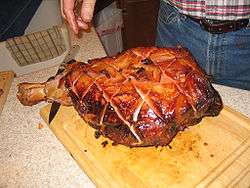Country ham
Country ham is a variety of cured ham, typically very salty. Country ham is first mentioned in print in 1944, referring to a method of curing and smoking done in the rural parts of North Carolina, South Carolina, Tennessee, Virginia, Georgia, Kentucky and other nearby Southern states. Virginia ham is a country ham produced in Virginia[1] (including the more-precisely-defined Smithfield ham); whereas "VA Style" refers to a curing style, not a location.[2]
Production
Country hams are salt-cured (and occasionally nitrite- and nitrate-cured) for one to three months. They may be hardwood (usually hickory and Red Oak) smoked, then aged for several months to 2–3 years, depending on the fat content of the meat.[3] Country hams are not fully cooked, but preserved by the cure. Smoking is not a legal requirement: some types of country ham, such as the "salt-and-pepper ham" of North Carolina, are not smoked. Smoking turns the meat a much redder color than unsmoked hams. They are usually sold in stores unrefrigerated as whole, bone-in hams packaged in rough cotton bags, with identifying markings printed on the bags. Country ham is also sold in presoaked, sliced, ready-to-cook form, usually vacuum-packaged.
Preparation

There are several methods of cooking a country ham including slicing and pan-frying, baking whole, and simmering for several hours (in several changes of water). Whole hams may need to be scrubbed and soaked for several hours before eating to remove the salt cure and mold. Even when soaked, they are still quite salty. For traditionalists, part of the appeal of country ham is this highly salty taste. Some eaters of country ham scrub, scrape, or pare off the outer crust of curatives, slice it, pan fry it, and eat it as is. Or they may fry the ham with the crust on. Some discard the crust; others consume it along with the meat. Traditionalists, when frying the ham, will typically only place it in a pan long enough to lightly brown it on both sides and to warm the meat. Frying times as short as thirty seconds per side are not uncommon.
Country ham is often served in restaurants as an entree as a whole slice, often with the femur cross-section left in. In addition, it is commonly used in a ham sandwich. It is also commonly served boned, sliced and then cut into pieces to be used in sandwiches in buttermilk (or similar) biscuits, sometimes with butter or red-eye gravy, made by adding water or coffee to country ham pan drippings and cooking down for a short time.
Country ham is in some ways similar to Italian uncooked prosciutto (prosciutto crudo), but prosciutto is not smoked, and is usually moister than a country ham. It is also usually sliced much thinner than the thicker traditional country ham "steaks" or even slices for sandwiches.
In the United States, country ham is frequently used in recipes that call for Jinhua ham, which is not available in the US, due to USDA import restrictions.
See also
- List of dried foods
- List of smoked foods
- Prosciutto, ham originating from central and northern Italy, usually dry-cured and not cooked.
References
- ↑ USDA Labeling Policy Book, p. 63
- ↑ Country Ham Recipe at 123recipes.com
- ↑ Kaminsky, Peter. (2005). Pig Perfect: Encounters with Remarkable Swine and Some Great Ways to Cook Them. Hyperion. 304 p. ISBN 1-4013-0036-7
Further reading
- Megan E. Edwards. "Virginia Ham: The Local and Global of Colonial Foodways," Food and Foodways 19 (Jan. 2011) 56-73
| ||||||||||||||||||